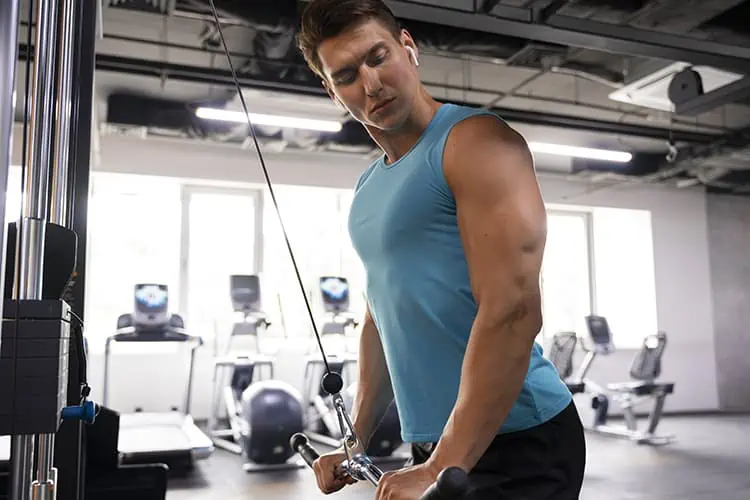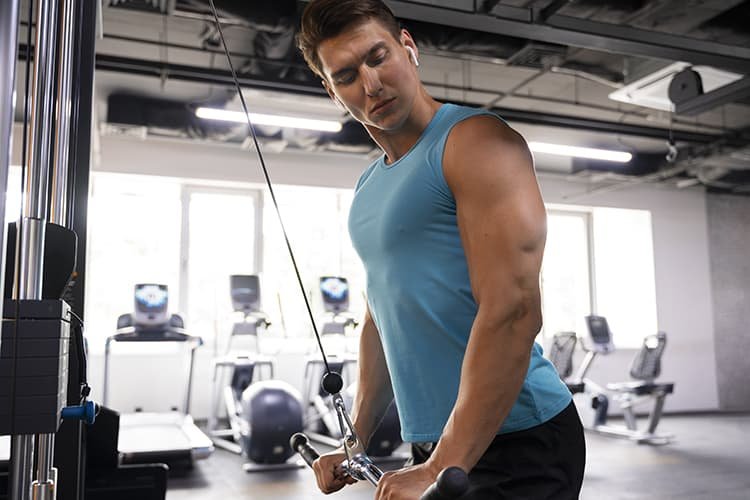
Tricep cable pushdowns are a staple in many fitness enthusiasts’ arm workouts. Not only do they target the triceps, the large muscle at the back of the arm, but they also offer a range of benefits from improving arm strength to improving muscle definition. This guide will delve into the technique, variations, and common mistakes of the tricep cable push to ensure you get the most out of this effective exercise.
Understanding the Triceps Cable Push Exercise
The tricep cable press, often referred to simply as a pushdown, is a resistance exercise that primarily targets the triceps. Performed on a cable machine using a rod or rope attachment. By pushing the limb down against the resistance of the weight, the exercise strengthens and tones the triceps.
The importance of proper technique
Proper technique is vital to maximizing the effectiveness of the tricep push while minimizing the risk of injury. Improper form can lead to strain on the elbows, shoulders, and even back, potentially putting you out of your workouts.
Step by Step Guide to the Perfect Pushdown
Setting up
Choosing the weight: Start with a lighter weight to focus on form. You can gradually increase the weight as you become more comfortable with the movement.
Setting up the cable: The cable should be placed high above your head. This positioning allows for a full range of motion during exercise.
Choosing your handle: You can use a straight bar, a V-bar, or a rope attachment. Each has its advantages, but starting with a straight bar can provide a solid grip for beginners.
Execution of the Exercise
The Home Position: Stand facing the cable machine, feet shoulder-width apart for stability. Grasp the attachment with both hands, palms facing down (grip up).
The movement: Keeping your elbows tucked in at your sides, exhale as you press the bar down until your arms are fully extended. The movement should be controlled and focused, with the movement coming from the elbows.
Return: Inhale as you slowly return the limb back to the starting position. Make sure the movement is controlled to maintain tension in the triceps.
Focus points
- Placement of elbows: Keep your elbows close to your body throughout the exercise to ensure that the triceps are effectively isolated.
- Range of motion: Aim for a full range of motion to fully engage the triceps. However, avoid locking your elbows at the bottom of the movement to maintain tension in the muscle.
- Posture: Keep a straight back and avoid leaning over the cable machine. This pose ensures that the focus remains on the triceps and helps prevent back strain.
Variations and Modifications
To keep your workouts fresh and continue to challenge your triceps, incorporating variations of the cable push can be beneficial.
Rope accessory
Using a rope attachment allows for a slight variation in wrist and hand position at the end of the movement where you can “stretch” the arms out. This action targets the triceps slightly differently, emphasizing the lateral (outer) head.
V-Bar attachment
The V bar offers a neutral grip, which may be easier on the wrists for some people. It also allows for a slightly different emphasis on the triceps muscles, potentially reducing stress on the elbow joints.
One arm pushdown
Doing the push-up with one arm at a time can help address any muscle imbalances by allowing you to focus on one side of the body. It also challenges your core stability as you work to maintain your posture.
Common mistakes to avoid with tricep cable presses
Several common mistakes can reduce the effectiveness of tricep thrusts or increase the risk of injury:
- Hyperextension of the elbows: Locking the elbows at the bottom of the movement can put unnecessary stress on the joint.
- Using excessive weight: This can lead to form breaking down, with the body leaning into the movement or the elbows flaring, reducing the effectiveness of the exercise.
- Bad posture: Bending over the machine or rounding the back takes the focus away from the triceps and can lead to back strain.
- Quick movements: Performing the pushdown too quickly can reduce its effectiveness and increase the risk of injury. Focus on controlled movements.
Incorporate Triceps Cable Pushdowns into your workout
Tricep cable pushdowns can be incorporated into an upper body or arm focused workout. They are usually performed towards the end of a workout, after compound exercises such as bench presses or dips, which also engage the triceps.
Arm Training Triceps Cable Push-Up Sample
- Dumbbell bench press: 3 sets of 8-10 repetitions
- Row bent over: 3 sets of 8-10 repetitions
- Dumbbell Overhead Extension: 3 sets of 10-12 repetitions
- Cable Triceps Pushdown: 3 sets of 12-15 repetitions
This structure allows the triceps to be engaged throughout the workout, but focuses on isolation towards the end when the muscles are already exhausted.
Advanced techniques for enhanced muscle activation
To further challenge the triceps and promote muscle growth, incorporating advanced techniques into your triceps cable push program can be extremely effective.
Eccentrically Focused Pushdowns
The eccentric, or lowering phase of an exercise, is vital to muscle growth and strength. To apply this to your pushdowns, increase the weight slightly above your normal work set and focus on a slow, controlled descent lasting 3-4 seconds before returning to the starting position. This technique puts more stress on the triceps, encouraging hypertrophy.
Drop Sets Cable Pushdowns Triceps
Once you reach muscle failure at a certain weight, immediately reduce the weight by 20-30% and continue performing the exercise until you reach failure again. This can be repeated for several drops, greatly enhancing muscle endurance and growth by fully exhausting the muscle fibers.
Supersets with additional exercises
Combining tricep cable presses with a supplemental exercise, such as overhead tricep extensions, can enhance your workout. Perform a set of pushdowns immediately followed by a set of overhead extensions without rest. This method helps target the triceps from different angles and trigger points, promoting balanced development.
Additional variations to target the triceps
Beyond the standard variations, the rope and V-bar, many other attachments and grips can introduce new challenges and stimuli to your triceps workouts.
Reverse Grip Cable Triceps Pushdowns
Performing the push-up with an underhand grip targets the medial head of the triceps more strongly. This grip variation can also reduce wrist strain for some people, making it a comfortable alternative.
Angled Bar Pushdown
Some cable machines offer an angled bar attachment, which can help change the position of the wrist and elbow slightly, offering a new stimulus to the muscles and potentially reducing joint discomfort.
Kneeling tricep cable
By performing the push-up in a kneeling position, you eliminate the ability to use your body weight to assist in the movement, forcing the triceps to work harder. This variation also helps maintain a more rigid torso, reducing the temptation to lean forward.
Overcoming Plateaus in Triceps Cable Push Development
Hitting a plateau in your training can be frustrating. Here are some strategies to keep making profits:
Vary the range and intensity of your reps
If you stick to the same set and rep range, changing it up can stimulate new growth. Experiment with lower reps and heavier weights or higher reps with lighter weights to challenge your muscles in new ways.
Focus on Nutrition and Recovery
Muscle growth isn’t just about what happens in the gym. Making sure you’re consuming enough protein, staying hydrated, and getting enough rest are all critical ingredients to overcoming plateaus.
Incorporate compound movements
While isolation exercises like the tricep push-up are effective for targeting specific muscles, compound movements involving multiple muscle groups can lead to overall strength and size gains. Incorporating exercises like close-grip bench presses or dips can provide new stimuli for growth.
Next steps
Learning the triceps cable press and its variations can improve you significantly arm workout regimen. By focusing on proper form, experimenting with different grips and components, and incorporating advanced techniques, you can ensure continued progress and avoid hitting a plateau. Remember, the key to growth is not only the exercises you choose but also how you perform them, how you recover and how you fuel your body. By taking a holistic approach to your fitness journey, incorporating these tips and staying consistent, you’ll see noticeable improvements in your triceps development and the overall aesthetics of your arms.
